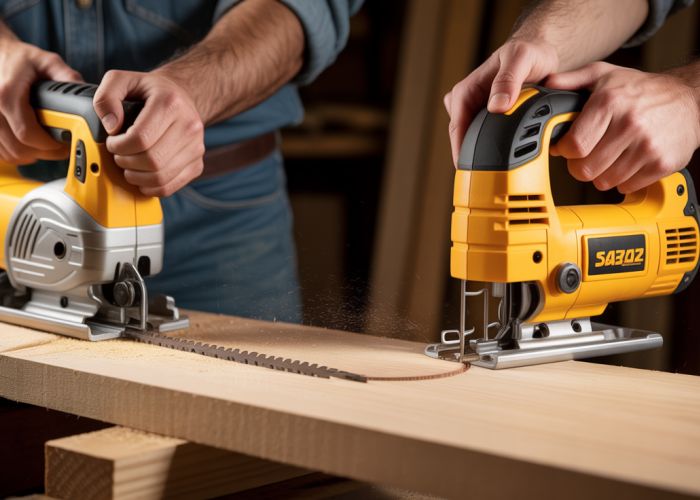The debate of sawzall vs jigsaw often surfaces when tackling demolition projects or intricate woodworking. A reciprocating saw, often called a sawzall, excels at rough cuts, while a jigsaw, a staple in many workshops, is known for its finesse in curved and detailed work. The choice between a Milwaukee sawzall and a quality jigsaw significantly impacts project efficiency. Understanding the distinct attributes of each tool, notably when determining sawzall vs jigsaw, helps any craftsman make the right selection for a given task.

Sawzall vs Jigsaw: Choosing the Right Tool for the Job
This guide will explore the differences between a Sawzall (reciprocating saw) and a Jigsaw, helping you determine which tool is best suited for your specific project. We will consider factors such as cutting capabilities, ease of use, and typical applications in our sawzall vs jigsaw analysis.
Understanding the Sawzall
A Sawzall, also known as a reciprocating saw, is a powerful tool primarily designed for demolition and rough cutting. Its forward-and-backward motion of the blade allows it to cut through various materials.
Key Features of a Sawzall:
- Aggressive Cutting Action: The reciprocating motion provides aggressive cutting suitable for thick materials.
- Versatile Blade Options: Different blades are available for cutting wood, metal, plastic, and even masonry.
- High Power: Typically more powerful than a jigsaw, allowing it to handle demanding tasks.
- Limited Precision: Due to its aggressive nature, it is not ideal for intricate or precise cuts.
Common Applications of a Sawzall:
- Demolition work (e.g., cutting through walls, pipes, and framing).
- Pruning large branches and trees.
- Cutting metal pipes and conduits.
- Rough cuts in lumber.
Understanding the Jigsaw
A Jigsaw is a versatile tool designed for making curved and intricate cuts in various materials. Its up-and-down motion of the blade, combined with the user’s ability to guide it, enables precise cutting.
Key Features of a Jigsaw:
- Precise Cutting Capabilities: Ideal for cutting curves, circles, and other intricate shapes.
- Variable Speed Control: Allows adjustment of the cutting speed for different materials and cut types.
- Bevel Cutting: Many jigsaws allow for bevel cuts (angled cuts).
- Orbital Action: Some models offer orbital action, which increases cutting speed but can reduce precision.
- Blade Variety: Numerous blade types cater to different materials and cutting styles.
Common Applications of a Jigsaw:
- Cutting curves and shapes in wood (e.g., furniture making, cabinetry).
- Cutting circles and holes in drywall or plywood.
- Cutting thin metal sheets.
- Making intricate cuts in plastic.
Sawzall vs Jigsaw: A Head-to-Head Comparison
The following table provides a direct comparison of the key features of a Sawzall and a Jigsaw, highlighting the strengths and weaknesses of each in various aspects of the sawzall vs jigsaw debate.
| Feature | Sawzall (Reciprocating Saw) | Jigsaw |
|---|---|---|
| Cutting Style | Aggressive, rough cutting | Precise, curved and straight cutting |
| Material Thickness | Handles thicker materials more easily | Best for thinner materials |
| Cut Precision | Low | High |
| Cutting Speed | Generally faster for rough cuts | Slower, especially for thicker materials |
| Portability | Typically more compact and easier to maneuver | Can be bulky depending on the model |
| Vibration | Higher vibration | Lower vibration |
| Ease of Use | Easier for straight cuts and demolition | Requires more skill for curved and precise cuts |
Choosing the Right Tool
Choosing between a Sawzall and a Jigsaw depends entirely on the project at hand. Ask yourself the following questions:
- What material am I cutting? Softer materials like drywall or thin plywood are often better suited for a Jigsaw, while thicker materials like lumber or metal require a Sawzall.
- How precise does the cut need to be? If precision is paramount, a Jigsaw is the clear choice. If you just need to quickly remove material, a Sawzall will get the job done faster.
- What is the shape of the cut? Straight cuts and demolition are the domain of the Sawzall, while curves and intricate shapes require a Jigsaw.
- What is my experience level? A Sawzall can be easier to handle for basic demolition tasks, while a Jigsaw requires more finesse, especially for complex cuts.
By considering these factors and understanding the capabilities of each tool, you can make an informed decision and choose the right tool for your project, resolving the sawzall vs jigsaw dilemma.
Sawzall vs Jigsaw: Frequently Asked Questions
Here are some common questions to help you better understand the key differences and applications of a Sawzall and a Jigsaw.
When should I always pick a Sawzall over a jigsaw?
For demolition work, cutting through thick materials like pipes or framing lumber, or jobs requiring raw power and speed, the Sawzall is the clear winner. The aggressive cutting action of a Sawzall is simply unmatched by a jigsaw in these scenarios.
Is a jigsaw suitable for cutting metal?
Yes, a jigsaw can cut metal, but it’s best for thinner sheets. You’ll need a blade specifically designed for metal and use a slower speed to prevent overheating and blade damage. For thicker metal, a Sawzall with a metal-cutting blade is typically a better choice.
Can I make curved cuts with a Sawzall?
While possible with a very short blade and a lot of experience, a Sawzall isn’t really designed for curved cuts. Jigsaws excel at intricate curves and detailed shapes, making them far more suitable for these tasks. It’s a core difference between the sawzall vs jigsaw.
What are the safety considerations when using a Sawzall?
Always wear safety glasses and gloves. Be aware of what’s behind the material you’re cutting, as the Sawzall’s aggressive action can easily cut through hidden objects. Secure the workpiece properly to prevent it from moving during cutting. Keep both hands firmly on the saw.
So, ready to put your new-found knowledge to work? Figuring out sawzall vs jigsaw doesn’t have to be a headache. Happy cutting!